This past summer, as humans were reeling and in retreat from the Covid-19 health threat, it seemed to me that the rest of nature was in full, robust health. It wasn’t just news stories about wildlife moving into now quieter urban areas, I was actually seeing it with my own eyes. Is it possible that nature was thriving because there was less human noise and traffic? Or maybe I just had more time to really see and appreciate the natural world around me? Regardless, it seemed like there were more bugs, more birds, more creatures, just more nature everywhere. And this included more mushrooms – popping up all over the place, including varieties I had never seen before.
I know almost nothing about mushrooms, so I made a pledge to myself to learn more about them, and this article is one result. Among other things, I’ve joined a subreddit called r/mycology, and by next summer I’m hoping to be able to identify at least some edible Ontario mushroom species so I can put my newfound hobby to practical use.
Mycology is the study of fungi (plural of fungus, and punch line of many lame jokes). Where fungi and mushrooms fit into the tree of life is as follows (Figure 1). All life on earth is thought to have a common ancestor and has evolved into three broad domains – the bacteria, the archaea, and the eukaryotes. Eukaryotic life is based on cells which contain nuclei, which obviously includes us (right there next to the slime molds!), but also the fungi. The kingdom of fungi is made up of 5 “true” phyla (there is a 6th under scientific debate) containing thousands upon thousands of species with complicated and easily forgotten Latin names. It is estimated that there are between 2.2 and 3.8 million fungus species, but only about 120,000 have been scientifically classified.

The fungi kingdom includes molds, yeasts, and the mushrooms. Interestingly, the more science learns about the fungi, the more they are considered closer to animals than plants. One way in which the two are similar is how they obtain nutrition – both animals and fungi break down molecules to achieve this, the former by ingesting food into the stomach, the latter typically by digesting substances outside themselves. Mushrooms do this by secreting enzymes which break down certain organic compounds, and then absorb the resulting nutritional components. In this way the fungi play an enormous role in the world around us and inside us, breaking down organic matter, something central to the grand circle of life, where organisms come to life, grow, thrive, die, then decompose and are reabsorbed into the environment, feeding new life.
Mushrooms are distinguished from all the other fungi by their fleshy bodies, with or without stems. This brings me back to my very first Science Break article (Kuhn, 2008) which included a description of Ophiocordyceps unilateralis, a fungus that grows inside a live ant and alters the ant’s behaviour, compelling it to climb to the top of a tree, and then the fungus sends its fruiting spike up and out of the top of the ant’s head! Is it a mushroom? No, it’s considered something else, part of the generus Ophiocordycep, which tells you a lot about how arbitrary and human-centric taxonomic systems are. I wonder if at some point the current taxonomic system will be replaced with something more objective, entirely based on genetics? But anyway, the term mushroom is really a non-scientific one, and refers to big, ground-based fungi with fleshy bodies that are either good for humans to eat, poisonous to humans, or have some kind of mind-altering qualities.
Identification
Identifying mushrooms is a popular hobby, but it’s complex and I may just settle for being able to safely identify one or two common edible mushrooms. It’s always in the back of my mind that a misidentification of an apparently edible mushroom could result in a dangerous or mind-altering experience.
Mycologists use many criteria to identify a mushroom, starting with obvious ones such as visual appearance, odor, habitat, time of year, and also including trickier ones such as nature of bruising, presence and characteristic of juices when cut, taste, appearance under microscope, and some chemical tests. One interesting way to identify basidiomycetes is to cut the cap off the stalk and place it gill side down on a sheet of glass (or a piece of paper that contrasts with the colour of the spores) and leave it undisturbed. Over time, usually overnight, the spores fall out of their tubes, and the resulting “spore print” can identify the mushroom species (Figure 2). Nowadays scientists mainly use molecular analysis to identify mushrooms.
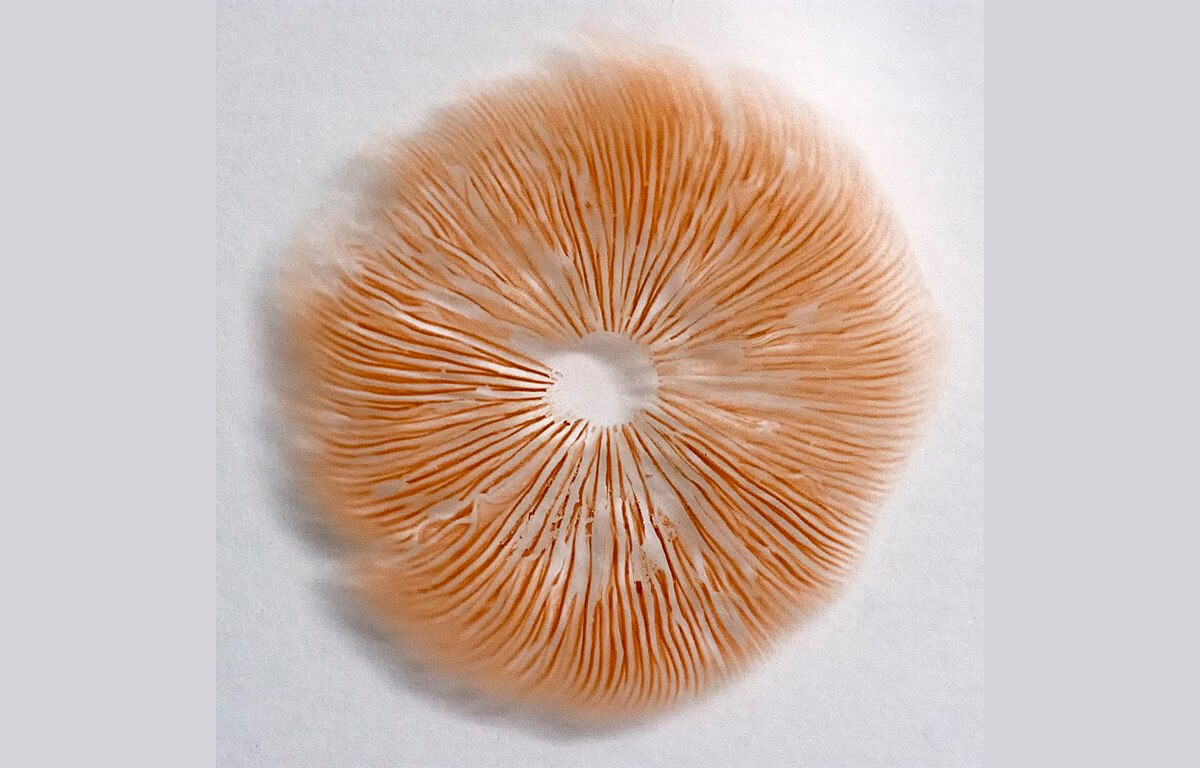
Parts of a mushroom
There is a huge variation of structures and features within the world’s mushrooms, so I will just describe the main features of a typical mushroom. Figure 3, a painting of the Amanita mushroom done by a relative of mine, Claus Caspari (he was my father’s cousin, and a renowned German scientific painter of mushrooms, plants, insects and minerals), really serves this purpose well. In the middle a fruiting body that is just starting out is shown (sometimes referred to as a button), and one can almost picture it growing into the mature mushroom on the left, the universal veil tearing open as the cap pops out the top, leaving bits of the veil on the top of the cap and the annulus around the stalk, with the delicate spore-bearing gills on the underside of the cap.
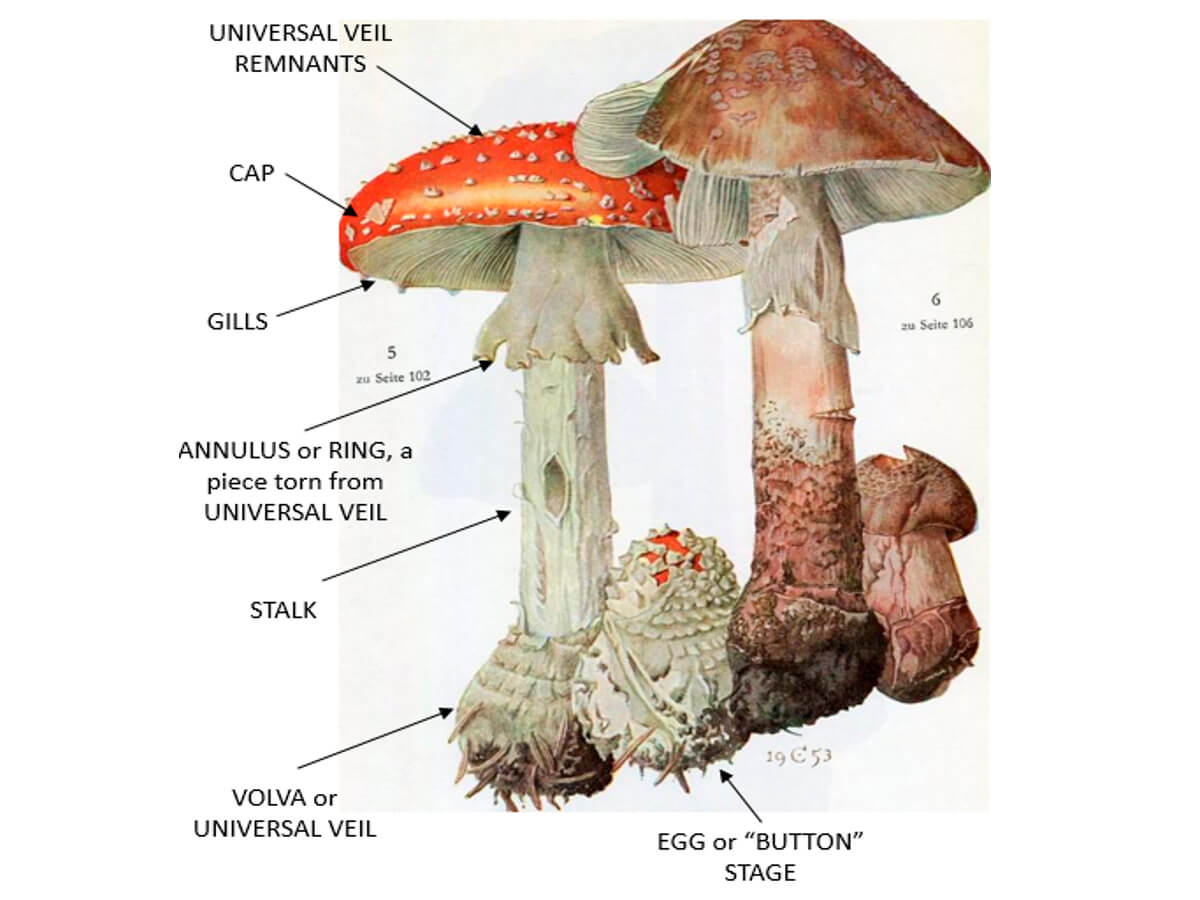
Spores, which will be covered in greater detail later on, are contained in many different ways among all the mushroom species – some within gills on the underside of the cap, some in sacs, some on the surface of the cap. There are two basic ways spores are contained though – internally stored spores are held within asci, externally stored spores are held within basidia. In the Amanita mushroom, spores are contained within basidia tubes between the gills.
The main body of the mushroom is all underground and is called the mycelium, and will now be covered in greater detail, in terms of its roles in deriving nutrition, and reproduction.
Mushroom nutrition
Referring back to Figure 3, the mycelium is not included in the painting. This is understandable, because a typical mycelium is an amorphous mass of fungal tissues embedded in the soil, and often quite large in volume. One type of mushroom is thought to be the largest organism on earth by area: a colony of Armillaria solidipes (formerly Armillaria ostoyae) in Oregon known as the “Humongous Fungus” is estimated to cover 9.6 km2 and weigh approximately 16,000 Kg. Figure 4 shows an oyster mushroom (Pleurotus ostreatus) mycelium spreading across coffee grounds. Once you know what they look like, you realise mycelia are very common and seen all the time, their white spreading tendrils very recognizable under fallen logs and the bark of dead or dying trees. The fruiting bodies that we think of as mushrooms come and go, but the mycelium hidden underneath really is the mushroom.
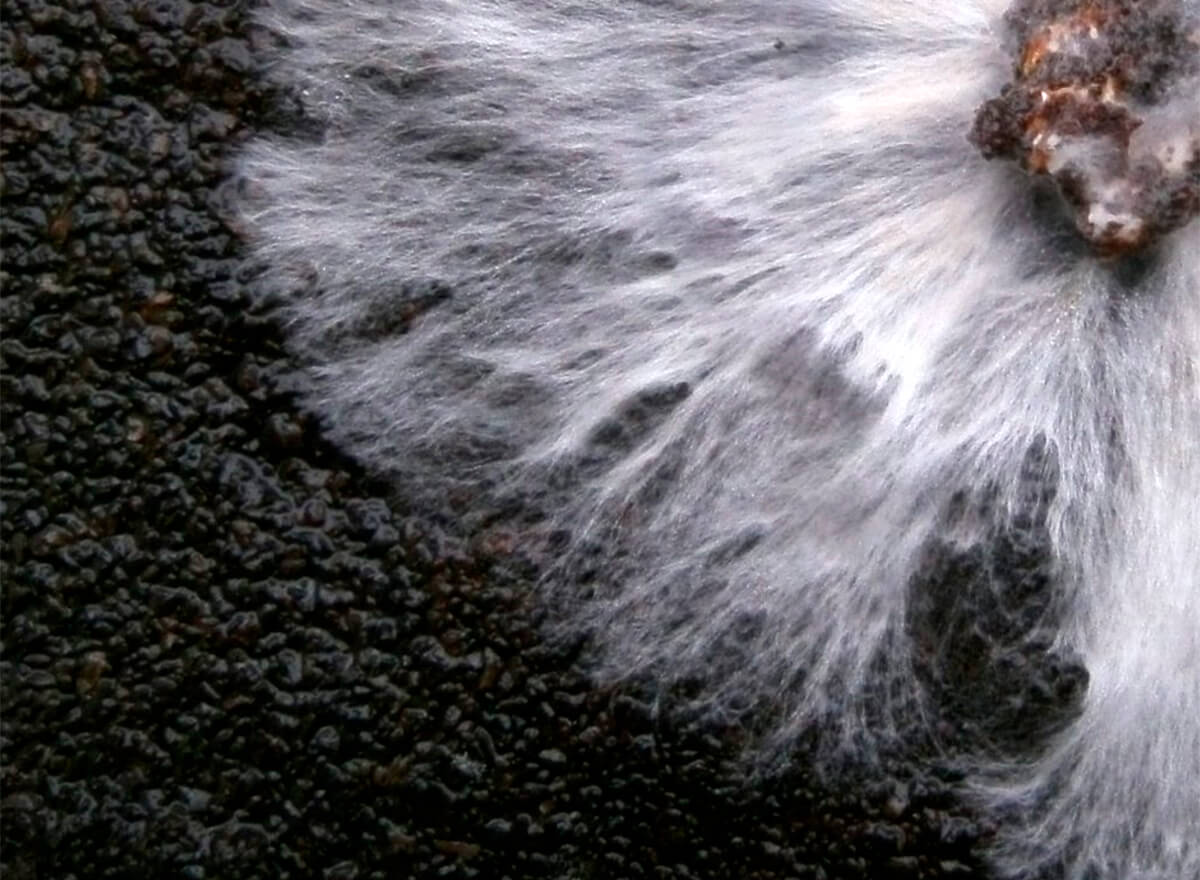
While it does play a role in reproduction, the mycelium’s main function is to obtain nutrition, and it can be thought of as a stomach turned inside out. It secretes enzymes which break down the organic matter they come into contact with. This results in an oozy, nutritious soup in and around the mycelium, which contains cells that can absorb the desired nutrients directly, just the sort of process that goes on in our stomachs.
Fungi obtain nutrients in three ways – feeding on a live host (parasitism), living with another organism in a way that is neutral and/or beneficial to both (mutualism), and through the decomposition of dead organic matter (saprotrophism). Mushrooms are largely saprotrophs, but I have no doubt that many have mutualistic aspects as well, and there are almost certainly parasitic mushrooms.
Most mushrooms use hydrolytic enzymes released from the tips of their hyphae to break down organic compounds such as polysaccharides, proteins, and lipids into smaller forms that can be absorbed. For example, the enzyme cellulase breaks down the polysaccharide cellulose, which is a very common material found in the walls of animal cells. Once the wall is breached then everything inside is accessible. The mushroom relies on the carbon found in the nitrate, ammonia, acetate, ethanol, and other simple compounds that it absorbs to fuel its growth and metabolism.
As an example of mutualism, the mycelium of some mushrooms develops a mycorrhizal symbiotic relationship with a plant species by growing around and sometimes actually right into the roots of the plant. The benefit to the mushroom is a constant supply of glucose produced by photosynthesis in the plant. The benefit to the plant is that the mycelium expands the surface area of its root system, improving the uptake of water and nutrients. This is probably a good opportunity to recommend an excellent book, Underland: A Deep Time Journey written by (Macfarlane, 2019). Very apropos for geoscientists, it goes underground literally and into the human psyche; I highly recommend it. One chapter explores the rapidly expanding study and understanding of the complex relationships between plants, all happening underground. For example, if one plant is attacked by a particular insect, it sends a chemical message via its root system, so that other plants nearby, including at times different species, can prepare their defenses. If a plant is sick, neighbouring plants detect this and can help it out by providing nutrients via their intertwined root systems, connected by fungi mycelia. This observed altruism of a sort, with no apparent benefit to the “charitable” plants, is creating a debate about whether the survival of the fittest evolutionary model is overly simplistic.
Reproduction
Let’s look at a typical mushroom life cycle, beginning with the release of spores from the fruiting body, again with a disclaimer that the mushroom world is highly complex, and there are all sorts of reproductive variations within the many species.
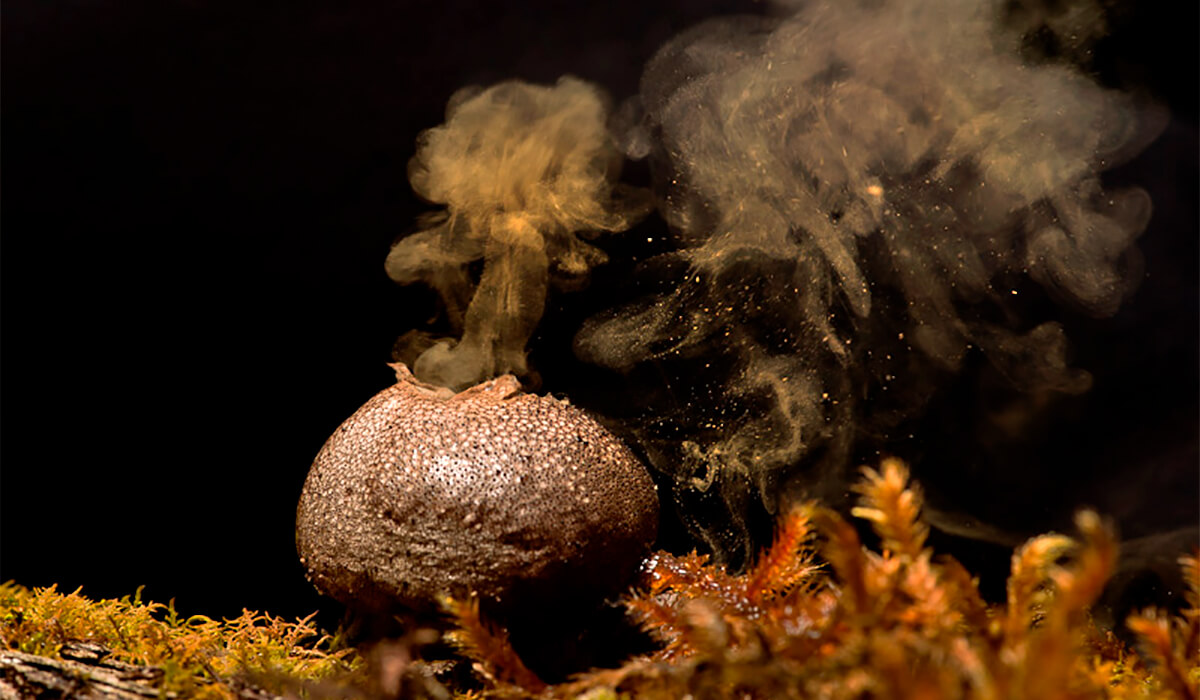
- Spore release The word spore is a generic term that refers to, “a minute, typically one-celled, reproductive unit capable of giving rise to a new individual without sexual fusion, characteristic of lower plants, fungi, and protozoans,” and is applied not just to mushrooms. In typical mushrooms the spore is a haploid single cell, that is its nucleus contains only a single copy of each chromosome. With asci spores, release occurs when the asci break open – a good example is the puffball mushroom (Figure 5).
- Inoculation Spores are very tiny and can float for great distances. If a spore lands in conditions favourable for growth – soft and moist soil for most species – this is called inoculation, and means the spore is ready for the next stage, germination.
- Germination The spore sprouts delicate filaments collectively called mycelium (but confusingly, hypha in the singular and hyphae in the plural), which spread into the surrounding soil. It is the mycelium which performs digestion as described earlier, but it also plays a role in reproduction. When a hypha encounters another hypha of the same species that is sexually compatible, the two fuse together to produce a secondary mycelium. However, like something from a Hallmark movie, this is not a full fusion - this secondary mycelium is still in the haploid stage; its newly formed cells dikaryotic, that is all they contain one unfused copy of each of the original nuclei. This state lasts for some time, but it’s not all hot chocolates and snowball fights, it actually represents the longest stage of most mushroom species’ lives.
- Mycelial expansion The new dikaryotic mycelium grows and spreads exponentially, fed by nutrients which it creates by breaking down organic matter it encounters and then absorbs. Along with the digestive enzymes it excretes, the mycelium also deploys an arsenal of compounds and enzymes which it uses to protect itself.
- Hyphal knot formation When conditions are right, the mycelium forms hyphal knots, which are the beginnings of the fruiting bodies known as primordia.
- Primordia growth A lot happens during this stage, and the mushroom absorbs many critical myco-nutrients, including polysaccharides, glycoproteins, ergosterols, and triterpenoids. All this goes into preparation of the fruiting bodies.
- Fruit body selection A mushroom will produce thousands of primordia, but then chooses only a few of the most promising ones for development into fruiting bodies. I assume this is done based on the constituent profiles of each of the primordia – I picture the battle commander surveying his troops and only choosing the strongest and bravest warriors for a hazardous mission.
- Mature fruitbody At this point the mushroom diverts all available energy and nutrients (presumably mainly taken from unused primordia) to the few selected fruit bodies. For most mushroom species, now is when karyogamy occurs, with the two different nuclei in each cell fusing into one single chromosome containing 50% of each parent’s DNA. In other words, the cells convert from being haploid to diploid – it’s the first kiss scene in the Hallmark movie! In most mushrooms this is immediately followed by meiosis, where each newly formed cell is pulled apart, forming two “daughter” haploid cells. It is these haploid cells that make up the mushroom spores. When they are ready, the fruiting bodies absorb water from their surroundings, expand up to tenfold in size, and explode out of the ground, literally appearing overnight to us, and spore release brings us back to the start of the cycle.
The description above applies to most mushrooms, but there are many variations. Some mushrooms are polykaryotic, meaning more than two mycelia fuse together, resulting in 6 or more different nuclei within each cell. This is definitely not suitable for a Hallmark movie NSFH), but the genetic diversity it can create in a single mushroom is an evolutionary advantage. For example, I read that if as little as 4% of a mycelium’s nuclei are resistant to a specific fungicide, that benefit can be conferred to the entire mycelium.
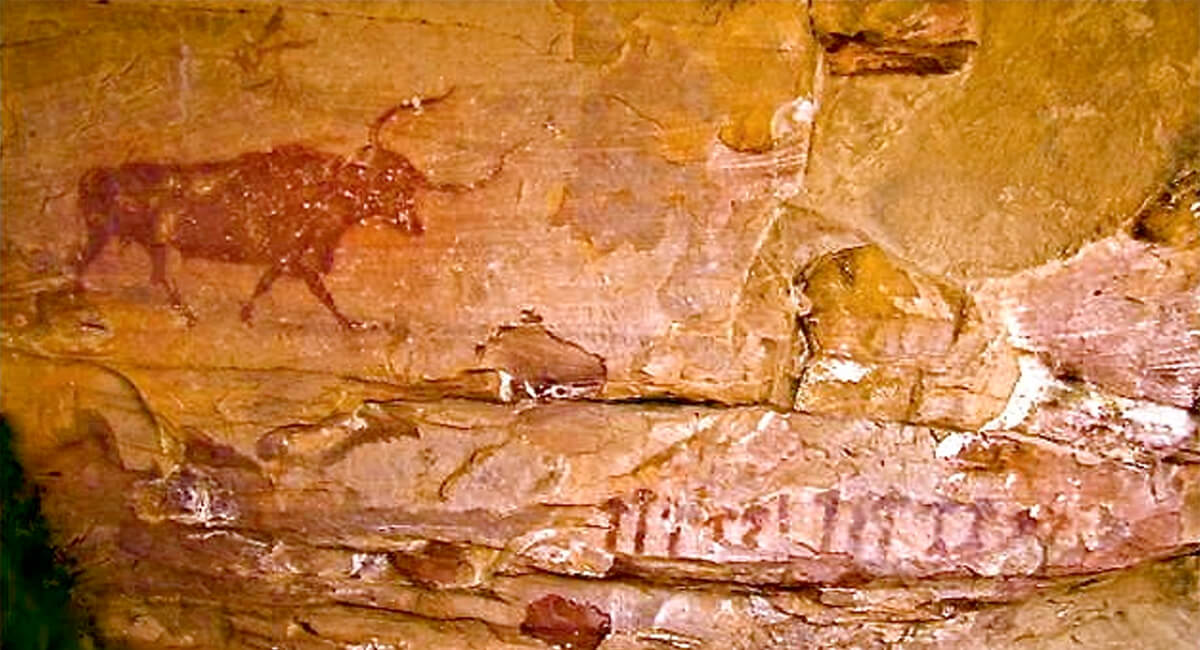
Mushrooms tend to be able to reproduce both sexually and asexually. Asexual reproduction usually happens before sexual reproduction, and often. Asexual reproduction can occur via growth from a piece of mushroom that has broken off, but many mushrooms can produce mitospores asexually, versus the meiospores that are produced sexually in the way described above in the 8-step life cycle. Asexual reproduction can happen many times prior to sexual reproduction, and obviously creates clones of the parent, which is how enormous genetically homogenous fungi such as the Humongous Fungus can be created.
Mushrooms as food
Mushrooms are incorporated into local cuisines the world over, not just for nutrition, but also because they can add interesting textures and flavours to dishes. Mushrooms are surprisingly nutritious. A 100 g raw serving of the species most commonly sold in North America, the Agaricus bisporus, while 94% water, can provide a significant proportion of the recommended daily value of several vitamins and minerals. This information is easily found on the Internet at sites such mushrooms.ca (Mushrooms Canada, 2020), which has an entire section on the nutritional properties of mushrooms.
In today’s society with highly efficient supply chains and large immigrant populations in most cities, an enticing variety of mushrooms is available in grocery stores. My challenge to CSEG members with culinary interests is to try cooking with some new and interesting mushrooms you might come across in your grocery store – there is no shortage of excellent recipes on the Internet for all types.
Psychoactive mushrooms
Humans have been aware of the psychoactive properties of certain types of mushrooms for thousands, perhaps hundreds of thousands of years. The most obvious and widespread are the Psilocybin mushrooms which closely resemble other edible mushrooms and are easily confused and eaten. It is extremely likely that humans discovered the effects of these mushrooms well before recorded history. Figure 6 shows the Selva Pascuala cave paintings, given a Neolithic date of about 4,000 BC. They appear to depict Psilocybe hispanica along the bottom. I’ve heard many speculations about psychoactive mushroom use from the ancient to recent past. For example, some explain the notorious Viking attack frenzy as an effect of Amanita muscaria, and people often attribute magic mushroom use to the Haida and other west coast peoples, but interestingly, there is no such use documented from historical sources; to explain this, some theorize that the ingestion of the mushrooms had evolved into a secret rite practiced only among the priest class. The role of mushrooms in cultures and spiritual practices in numerous societies throughout history is certainly an interesting topic, but not the focus of this article. However, I think it’s worth giving an overview of the western scientific community’s engagement with this area.
Beginning in the 1950’s, you have two main fields getting involved - the social scientists coming at it from a broad cultural angle, and the natural scientists from a more narrow one involving molecular biology, chemistry, taxonomy and so on – all against a backdrop of a society on the verge of the wild 1960’s countercultural changes.
Some people point to R. Gordon Wasson’s article “Seeking the Magic Mushroom”, published in the May 13, 1957 issue of Life magazine, as the start of the West’s investigation of psychoactive mushrooms. As the 1960’s show, North American society was ripe at this time to explore an exotic world outside the fairly narrow, conservative post-war experience of the white majority. Academia and the baby boomers in general seized on the topic, and research into the use of hallucinatory mushrooms in historical and current cultures flourished. This clearly established that mushrooms and their mind-altering effects were part, perhaps central to, of the cultural practices of many past societies, such as numerous depictions of mushrooms in Mesoamerican religious art suggest.
However, some of the theories put forth then were more at the unlikely end of the spectrum, such as Terence McKenna’s belief that it was hallucinogenic mushroom use by primitive humans which drove the evolution of the modern human brain, coined the “stoned ape theory”. McKenna apparently read both Carl Jung and Wasson’s article in 1957 when he was 10, which started him on his research path, along with many others, such as Timothy Leary. You know the rest – a big part of the 1960’s was a quest in the Western world to find more meaning in life, which for many people involved alternative religions and philosophies, other cultures, and experimentation with drugs. Psychoactive mushrooms could be found at the intersection of these three, and so they became a big part of the zeitgeist. You still find anthropologists soldiering on in this field, trekking to remote parts of the world and documenting the use of psychotropic drugs. Older CSEG members will recall a convention lunch talk given by Wade Davis, where he dramatically described how he believed Haitian vodou priests used tetrodotoxin derived from the puffer fish to induce temporary deathlike paralysis in people, an explanation for zombies. I admit, that kind of stuff is interesting.
Meanwhile, the other kind of scientists were figuring out the active ingredients of the various psychoactive mushrooms, often in the pursuit of commercial drug development. In 1959 they identified psilocybin as being the active ingredient of the so-called magic mushrooms, made up of about 200 mushroom species in the division Basidiomycota. When ingested, the psilocybin is broken down by the liver into psilocin, which acts on the serotonin receptors, causing a broad range of hallucinatory effects, depending on factors such as the mood and brain chemistry of the user. Research into psilocybin’s use as a medicine started, but then was increasingly restricted by anti-drug laws, part of a societal pushback against all the liberalisation around recreational drug use, and eventually was shut down in the US in 1970, and in many other countries. Recently this research has begun again and shows some promise to find ways to medicate mental illnesses such as depression. Just as I was finishing this article, I came across a short piece in Discover magazine that focuses on the resurgence in psilocybin medical research (Learn, 2020).
In 1964 the active ingredients in Amanita muscaria, mainly muscimol, muscazine, muscazone and ibotenic acid, were identified, and in 1965 muscimol was synthesized. This summer some Amanita muscaria popped up along a path at my mother’s place (Figure 7). This type of toadstool, with its very vivid red and white colouring, is easily recognizable and hard to confuse with other mushrooms. It literally shouts out, “RECREATIONAL DRUG USE!” Muscimol mimics a naturally occurring neurotransmission inhibitor found abundantly in all mammalian brains, gamma-Aminobutyric acid (GABA). In a normally functioning brain, appropriate levels of GABA control the flow of chloride ions through the GABA receptors, allowing them to act as neural gates, with excitatory, inhibitory, and neutral states achieved by flow in one direction, the other direction, and no flow at all (shunting). GABA is the most common such neurotransmitter in mammal brains, so muscimol affects many regions including the cerebellum, hippocampus and cerebral cortex. This means the possible effects experienced are broad, including sedation, excitation, and hallucination. Ingesting Amanita muscaria directly can be very dangerous, fatal in rare cases, and the mushrooms need to be parboiled a couple of times to reduce their toxicity prior to eating them. One culture in Siberia discovered that when reindeer eat Amanita, a safe level of muscimol passes through their digestive systems, so they developed the practice of drinking the reindeer urine to achieve the desired mind-altering effects. Personally, I would opt for the parboiling route, but there is no accounting for taste.
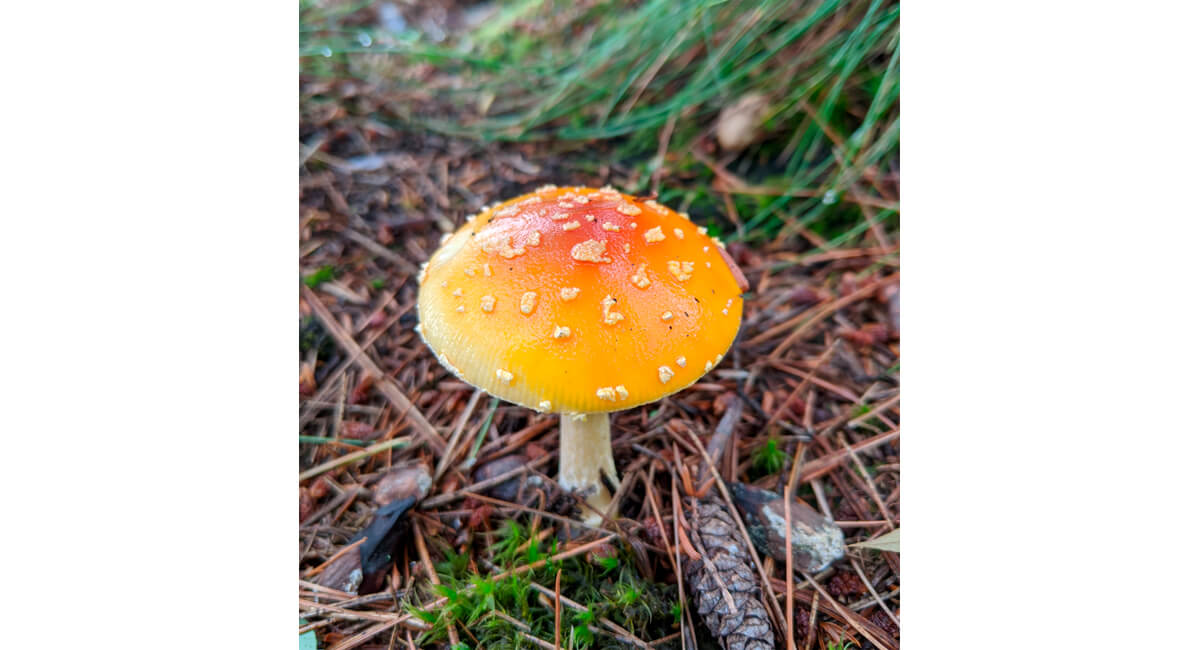
There are types of mushrooms with other types of mind-altering substances, mainly those containing phenethylamines, which is a class of drugs similar to amphetamines, and the cannabinoids, whose effects we are generally familiar with given the recent trend towards legalisation.
Toxic mushrooms
I thought I would end with this section, so instead of being inspired to gorge on wild mushrooms, parboil Amanita, or go on a west coast kayak “trip”, readers will be left thinking about some of the dangers around ingesting wild mushrooms. Wikipedia states that there is a “small number” of mushroom species that pose a significant risk of death if ingested, and then lists out 34 of them, 12 of which are found in North America, 18 in Europe; 11 of them are types of Amanita (Wikimedia Foundation, Inc., 2020). A further list of 10 mushroom species is given, including Amanita muscaria, associated with isolated deaths. Listed beside each poisonous species are the edible species that they resemble, highlighting the dangers associated with eating wild mushrooms. It is estimated that about one third of the mushroom poisonings in the US each year happen because Psilocybin hunters mistakenly pick and eat poisonous ones.
The toxins in mushrooms most likely evolved to discourage animals from eating the fruiting bodies, thus destroying the spores that the mushrooms devoted considerable resources towards creating. Most of the significantly dangerous mushrooms on the Wikipedia list contain toxins that cause liver, kidney or central nervous system damage or failure. Gyromitra can deplete the enzyme pyridoxal phosphate (PLP) to the point of death; Podostroma cornudamae affects the bone marrow, brain and skin; Paxillus involutus, a very innocuous looking North American mushroom that looks edible, can cause potentially deadly autoimmune reactions and hemolysis (the rupturing of red blood cells – basically you can bleed to death internally); Trogia venenata can cause deadly cardiac arrhythmia and hypoglycemia, a condition given the name Yunnan sudden death syndrome. Most of the occasionally fatal mushrooms cause severe gastrointestinal reactions, but a couple cause rhabdomyolysis, a nasty condition where skeletal muscle tissue breaks down rapidly, and Pleurocybella porrigens, ironically called angel wings, causes neurotoxic damage. In addition to these natural defenses, mushrooms tend to pick up and concentrate toxins, heavy metals, and other dangerous substances that humans have introduced to the environment. Apparently mushrooms in the vicinity of Chernobyl are still quite dangerous to eat.
Mushrooms – fascinating, beautiful, tasty, intoxicating, and sometimes deadly.











Share This Column